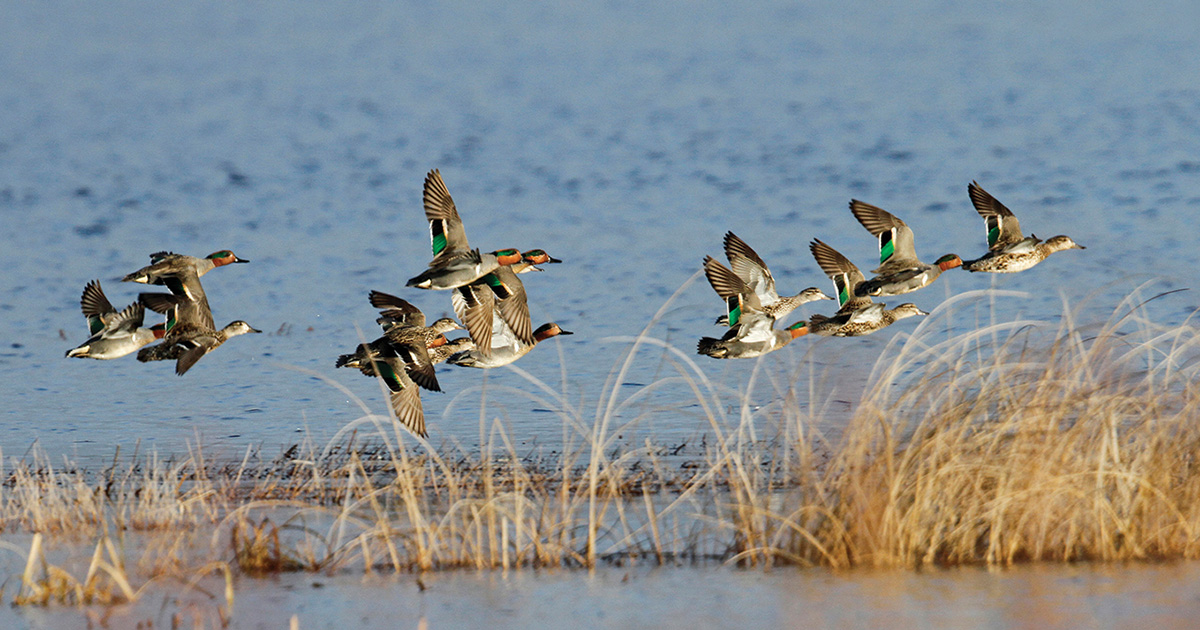Migration Alert: Changing Conditions in the Upper Midwest Should Improve Habitat
Sept. 28, 2023 – Mississippi Flyway – Upper Midwest
Sept. 28, 2023 – Mississippi Flyway – Upper Midwest

As waterfowl seasons open across the upper tier of the Midwest and Great Lakes, the biggest factor impacting waterfowl remains water, or lack thereof. Some of the driest conditions are found in Minnesota and Wisconsin. Thankfully, both states boast many rivers and permanent lakes that should have sufficient water to support waterfowl during migration. Moreover, receding water levels have promoted the growth of beneficial vegetation in many wetland basins. While a lack of water remains an issue in some areas, quenching rains across Minnesota during the North Zone opener last weekend flooded new areas of habitat for waterfowl.
“We have been pretty dry the past few years, which has allowed a lot of important wetland plants to thrive,” says John Lindstrom, a DU biologist in Minnesota. “Last weekend some parts of the state received four-plus inches of rain, which should have inundated a lot of wetlands. Hunters taking advantage of this newly available habitat should have success.”
Many Wisconsin hunters are still dealing with dry marshland and a lack of access to hunting areas across much of the state. While big water options are readily available, all that good duck food will remain high and dry until substantial precipitation occurs.
“It’s dry, but there are good numbers of birds where water is present,” says Brian Glenzinski, a DU biologist in Wisconsin. “Moist-soil areas are full of food, so if we get some fall rains, we should have excellent conditions and hopefully hold ducks a little longer.”
Despite ongoing drought conditions across much of the region, water levels remain relatively high in the Upper Great Lakes. This will also be important for key migration hot spots such as Saginaw Bay, Lake St. Clair, and the Western Basin of Lake Erie.
Michigan’s Upper Peninsula is sandwiched between three Great Lakes, and the massive St. Marys River system along its eastern border is a major migration corridor for Mississippi and Atlantic Flyway waterfowl.
“Right now, water levels offer decent habitat conditions. Some inland waters may be a little on the dry side, but the St. Marys River system has a good amount of marsh habitat available,” explains Dave Jentoft, Michigan Department of Natural Resources (MDNR) wildlife biologist. “We have had warm, dry conditions here of late, but I don’t know how much that will impact the season. We have lots of agricultural fields in the far east end. If it rains, we typically have some wet areas, but we just haven’t had enough rain for that.”
Jentoft has not observed or heard any substantial migration reports, but still expects a busy opening weekend in the Upper Peninsula.
In downstate Michigan, MDNR wildlife technician Mike Richardson based at Allegan State Game Area offers some advice. “We are seeing various dabblers moving in as well as geese, but waterways are low, and we need rain badly. Being near decent-sized waterbodies is going to be important early on, as some of the smaller ponds and wetlands may still be dry if the current forecast holds.”
According to DU biologist Madelyn McFarland, the story is the same across the state line in Indiana and Illinois. “Most of northern Illinois and Indiana are experiencing drought conditions, which has facilitated some good vegetation production in our wetlands, especially moist-soil plants," she reports. "We’ll hopefully get some rain just in time for the peak of fall migration.”
Mike Sertle, DU manager of conservation programs in Indiana and Illinois, concurs. “There is a lot of food with the low water, but conditions need to improve in order to provide adequate water for the birds to access it this year,” he says.
With all the dry talk, there is a silver lining. Kali Rush, DU biologist in Michigan, explains the importance of drought when it comes to wetland health. “It is normal for wetlands to experience wet and dry cycles, and it's crucial to maintaining their diversity and health," she notes. "As we learned from the recent waterfowl survey results, mallards and total ducks are down from last year and the long-term average. DU is accelerating the pace of putting habitat on the ground and working with renowned scientists to best inform our habitat delivery efforts.”
Stay up to date with the latest migration information.